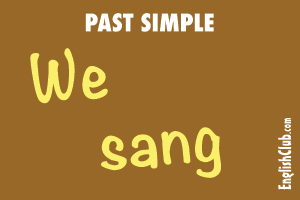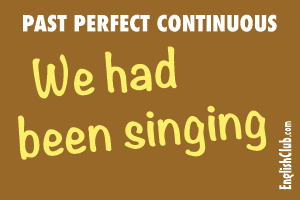Past Tense
Past Simple

The Past Simple tense is sometimes called the "preterite tense". We can use several tenses and forms to talk about the past, but the Past Simple tense is the one we use most often.
In this lesson we look at the structureand use of the Past Simple tense, followed by a quiz to check your understanding.
How do we make the Past Simple tense?
There are two basic structures for the Past Simple tense:
1. Positive sentences
| subject | + | main verb |
| Past Simple |
2. Negative and question sentences
| subject | + | auxiliary do | + | main verb |
| conjugated in Past Simple | ||||
| did | base |
Look at these examples with the main verbs go (irregular) and work (regular):
| subject | auxiliary verb | main verb | |||
|---|---|---|---|---|---|
| + | I | went | to school. | ||
| You | worked | very hard. | |||
| - | She | did | not | go | with me. |
| We | did | not | work | yesterday. | |
| ? | Did | you | go | to London? | |
| Did | they | work | at home? |
From the above table, notice the following points...
For positive sentences:
- There is no auxiliary verb.
- The main verb is conjugated in the Past Simple, invariable: -ed (or irregular)
For negative and question sentences:
- The auxiliary is conjugated in the Past Simple, invariable: did
- The main verb is invariable in base form: base
- For negative sentences, we insert not between the auxiliary verb and main verb.
- For question sentences, we exchange the subject and the auxiliary verb.
Emphatic did
Normally, for positive sentences we do not use the auxiliary did. But if we want to emphasize (stress) something, or contradict something, we may use it. For example: "I didn't use a spellchecker but I did use a dictionary." Here are some more examples:
Normally, for positive sentences we do not use the auxiliary did. But if we want to emphasize (stress) something, or contradict something, we may use it. For example: "I didn't use a spellchecker but I did use a dictionary." Here are some more examples:
- "Why didn't you go to the party?" / "I did go."
- It did seem a bit strange.
- After drinking it I did in fact feel better.
Past Simple with main verb be
The structure of the Past Simple with the main verb be is:
| subject | + | main verb be |
| conjugated in Past Simple | ||
| was, were |
Look at these examples with the main verb be:
| subject | main verb be | |||
|---|---|---|---|---|
| + | I, he/she/it | was | here. | |
| You, we, they | were | in London. | ||
| - | I, he/she/it | was | not | there. |
| You, we, they | were | not | happy. | |
| ? | Was | I, he/she/it | right? | |
| Were | you, we, they | late? |
From the above table, notice the following points...
- There is no auxiliary verb, even for questions and negatives.
- The main verb (be) is conjugated in the Past Simple: was, were
- For negative sentences, we insert not after the main verb.
- For question sentences, we exchange the subject and the main verb
Past Continuous

The Past Continuous tense is an important tense in English. We use it to say what we were in the middle of doing at a particular moment in the past.
In this lesson we look at the structureand the use of the Past Continuous tense, followed by a quiz to check your understanding.
Note that continuous tenses are also called progressive tenses. So the Past Continuous tense is sometimes called the Past Progressive tense.
How do we make the Past Continuous tense?
The structure of the past continuous tense is:
| subject | + | auxiliary be | + | main verb |
| conjugated in Past Simple | ||||
| was, were | present participle |
The auxiliary verb (be) is conjugated in the Past Simple: was, were
The main verb is invariable in present participle form: -ing
For negative sentences we insert not between the auxiliary verb and the main verb.
For question sentences, we exchange the subject and the auxiliary verb.
Look at these example sentences with the Past Continuous tense:
| subject | auxiliary verb | main verb | |||
|---|---|---|---|---|---|
| + | I | was | watching | TV. | |
| + | You | were | working | hard. | |
| - | He, she, it | was | not | helping | Mary. |
| - | We | were | not | joking. | |
| ? | Were | you | being | silly? | |
| ? | Were | they | playing | football? |
The spelling rules for adding -ing to make the Past Continuous tense are the same as for the Present Continuous tense.
How do we use the Past Continuous tense?
The Past Continuous tense expresses action at a particular moment in the past. The action started before that moment but has not finished at that moment. For example, yesterday I watched a film on TV. The film started at 7pm and finished at 9pm.
| At 8pm yesterday, I was watching TV. | ||||||
| past | present | future | ||||
| ||||||
| At 8pm, I was in the middle of watching TV. | ||||||
When we use the Past Continuous tense, our listener usually knows or understands what time we are talking about. Look at these examples:
- I was working at 10pm last night.
- They were not playing football at 9am this morning.
- What were you doing at 10pm last night?
- What were you doing when he arrived?
- She was cooking when I telephoned her.
- We were having dinner when it started to rain.
- Ram went home early because it was snowing.
Note that some verbs cannot be used in continuous/progressive tenses.
We often use the Past Continuous tense to "set the scene" in stories. We use it to describe the background situation at the moment when the action begins. Often, the story starts with the Past Continuous tense and then moves into the Past Simple tense. Here is an example:
"James Bond was driving through town. It was raining. The wind was blowing hard. Nobody was walking in the streets. Suddenly, Bond saw the killer in a telephone box..."
Past Continuous + Past Simple
We often use the Past Continuous tense with the Past Simple tense. We use the Past Continuous to express a long action. And we use the Past Simple to express a short action that happens in the middle of the long action. We can join the two ideas with when or while.
In the following example, we have two actions:
- long action (watching TV), expressed with Past Continuous
- short action (telephoned), expressed with Past Simple
| past | present | future | ||||||||
| long action: I was watching TV from 7pm to 9pm. | ||||||||||
| ||||||||||
| short action: You phoned at 8pm. | ||||||||||
We can join these two actions with when:
- I was watching TV when you telephoned.
Notice that "when you telephoned" is also a way of defining the time (8pm).
We use:
- when + short action (Past Simple)
- while + long action (Past Continuous)
There are four basic combinations:
| I was walking past the car | when | it exploded. | |
| When | the car exploded | I was walking past it. | |
| The car exploded | while | I was walking past it. | |
| While | I was walking past the car | it exploded. |
Notice that the long action and short action are relative.
- "Watching TV" took two hours. "Telephoned" took a few seconds.
- "Walking past the car" took a few seconds. "Exploded" took milliseconds
Past Perfect

The Past Perfect tense is quite an easy tense to understand and to use. This tense talks about the "past in the past".
In this lesson we look at the structureand use of the Past Perfect tense, followed by a quiz to check your understanding.
How do we make the Past Perfect tense?
The structure of the Past Perfect tense is:
| subject | + | auxiliary have | + | main verb |
| conjugated in Past Simple | ||||
| had | past participle |
The auxilary verb (have) is conjugated in the Past Simple: had
The main verb is invariable in past participle form: -ed (or irregular)
For negative sentences we insert not between the auxiliary verb and the main verb.
For question sentences, we exchange the subject and the auxiliary verb.
Look at these example sentences with the Past Perfect tense:
| subject | auxiliary verb | main verb | |||
|---|---|---|---|---|---|
| + | I | had | finished | my work. | |
| + | You | had | stopped | before me. | |
| - | She | had | not | gone | to school. |
| - | We | had | not | left. | |
| ? | Had | you | arrived? | ||
| ? | Had | they | eaten | dinner? |
Contraction with Past Perfect
When we use the Past Perfect in speaking, we often contract the subject and the auxiliary verb. We also sometimes do this in informal writing:
| I had | I'd |
| you had | you'd |
| he had she had it had | he'd she'd it'd |
| we had | we'd |
| they had | they'd |
- I'd eaten already.
- They'd gone home.
In negative sentences, we may contract the auxiliary verb and "not":
- I hadn't finished my meal.
Past Perfect

The Past Perfect tense is quite an easy tense to understand and to use. This tense talks about the "past in the past".
In this lesson we look at the structureand use of the Past Perfect tense, followed by a quiz to check your understanding.
How do we make the Past Perfect tense?
The structure of the Past Perfect tense is:
| subject | + | auxiliary have | + | main verb |
| conjugated in Past Simple | ||||
| had | past participle |
The auxilary verb (have) is conjugated in the Past Simple: had
The main verb is invariable in past participle form: -ed (or irregular)
For negative sentences we insert not between the auxiliary verb and the main verb.
For question sentences, we exchange the subject and the auxiliary verb.
Look at these example sentences with the Past Perfect tense:
| subject | auxiliary verb | main verb | |||
|---|---|---|---|---|---|
| + | I | had | finished | my work. | |
| + | You | had | stopped | before me. | |
| - | She | had | not | gone | to school. |
| - | We | had | not | left. | |
| ? | Had | you | arrived? | ||
| ? | Had | they | eaten | dinner? |
Contraction with Past Perfect
When we use the Past Perfect in speaking, we often contract the subject and the auxiliary verb. We also sometimes do this in informal writing:
| I had | I'd |
| you had | you'd |
| he had she had it had | he'd she'd it'd |
| we had | we'd |
| they had | they'd |
- I'd eaten already.
- They'd gone home
Past Perfect Continuous

The Past Perfect Continuous is another tense that expresses the "past in the past".
In this lesson we look at the structureand use of the Past Perfect Continuous tense, followed by a quiz to check your understanding.
Note that continuous tenses are also called progressive tenses. So the Past Perfect Continuous tense is sometimes called the Past Perfect Progressive tense.
How do we make the Past Perfect Continuous tense?
The structure of the Past Perfect Continuous tense is:
| subject | + | auxiliary have | + | auxiliary be | + | main verb |
| conjugated in Past Simple | past participle | |||||
| had | been | present participle |
The first auxiliary verb (have) is conjugated in the Past Simple, invariable: had
The second auxiliary verb (be) is invariable in past participle form: been
The main verb is invariable in present participle form: -ing
For negative sentences we insert not after the first auxiliary verb.
For question sentences, we exchange the subject and the first auxiliary verb.
Look at these example sentences with the Past Perfect Continuous tense:
| subject | auxiliary verb | auxiliary verb | main verb | |||
|---|---|---|---|---|---|---|
| + | I | had | been | working. | ||
| + | You | had | been | playing | tennis. | |
| - | It | had | not | been | working | well. |
| - | We | had | not | been | expecting | her. |
| ? | Had | you | been | drinking? | ||
| ? | Had | they | been | waiting | long? |
Contraction with Past Perfect Continuous
When we use the Past Perfect Continuous in speaking, we often contract the subject and the first auxiliary verb. We also sometimes do this in informal writing.
| I had been | I'd been |
| you had been | you'd been |
| he had been she had been it had been | he'd been she'd been it'd been |
| we had been | we'd been |
| they had been | they'd been |
- He'd been drinking all day.
- It'd been pouring with rain.
In negative sentences, we may contract the first auxiliary verb and "not"


Nice g bht manat ki ha lgta ha.
ReplyDeletethnks
ReplyDelete